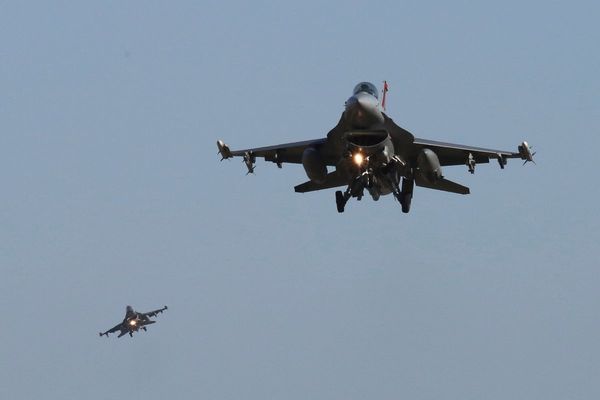The Senate version of the fiscal 2026 defense policy bill would authorize an extra $32.1 billion for national security spending above what the Pentagon sought, putting the chamber on a collision course with the House and the Trump administration.
Provisions in the legislation also differ with policies espoused by President Donald Trump and Defense Secretary Pete Hegseth — particularly related to potential U.S. troop changes in Europe and support of Ukraine.
The bill, the text of which has not yet been released, was approved behind closed doors on Wednesday night. The legislation would provide a total of $924.7 billion for national defense, according to an executive summary released by the Senate Armed Services Committee on Friday.
That includes $878.7 billion for the Defense Department plus $35.2 billion for nuclear programs within the Department of Energy and $10.8 billion for defense-related activities outside the committee’s jurisdiction.
By contrast, a draft version of the House Armed Services Committee’s fiscal 2026 National Defense Authorization Act recommends $882.6 billion in national defense spending, of which $848.3 billion is for the Pentagon — totals that are in line with what the White House requested.
The difference in approaches is reminiscent of last year, when Senate defense hawks authorized $25 billion more for defense than what then-President Joe Biden had requested, a sum that also flew in the face of statutory budget caps and was ultimately scuttled in the final version of the bill.
This year, the Trump administration has touted its planned investments in national defense, which when including $113.3 billion packaged in the reconciliation bill that just cleared Congress, tops $1 trillion for national security in fiscal 2026 — $961.6 billion of which would go to the Defense Department.
Under the Senate bill, when paired with reconciliation, Defense Department funding would be roughly $991 billion, a senior congressional official told reporters during a background briefing Friday on the contents of the chamber’s version of the legislation.
Officials also underscored the challenges they faced in crafting the annual defense policy bill.
“We had a very late budget submission,” an official said. “We didn’t have a lot of details. We were writing reconciliation in the dark. And there is a massive misalignment in certain places with what the administration is expecting and what we did in reconciliation, so we’re trying to backfill that and make sure that we’re filling those gaps.”
The final vote in committee was 26-1, according to the summary — Sen. Elizabeth Warren, D-Mass., was the lone dissenting vote, per a source familiar.
Procurement plus-ups
The committee’s single-biggest dollar add went to shipbuilding, a senior congressional official said, with the account getting an $8.5 billion boost.
The executive summary states the bill would authorize the procurement of up to five Columbia-class ballistic missile submarines. The budget request included funding for a single Columbia-class ship.
Meanwhile, the Senate version would also fund the purchase of 34 F-35 fighter jets used by the Air Force. The total is 10 more than the two dozen the service sought to buy in fiscal 2025.
The requested number of F-35s has drawn attention on and off the Hill because it’s roughly half the number defense officials expected they would procure next year, according to past budget projections. An Air Force spokeswoman wrote in a Friday email that the service “made tough choices to decrease procurement and reprioritize funding for sustainment and operational availability” of the existing fleet of F-35As (the conventional variant of the aircraft), which numbers nearly 500.
The committee recommended adding roughly $6 billion to the Defense Department’s munitions budget, a second senior congressional official said, though it’s unclear how that money is distributed. Meanwhile, the panel added “a couple of billion” dollars for each of the service’s unfunded priorities list requests, the official said, but it’s unclear which items were authorized.
Ukraine
The Senate version would notably extend U.S. aid to Kyiv via the Ukraine Security Assistance Initiative through 2028, while boosting the authorized total annually from $300 million to $500 million, the summary shows.
The legislation would also require the Defense secretary to continue sharing intelligence with Ukraine’s government, per the summary, while reaffirming U.S. policy is “to assist Ukraine in maintaining a credible defense and deterrence capability.”
A third senior congressional official said the language aims to “show in a bipartisan way we continue to support aiding Ukraine.”
“We’ve extended and reauthorized USAI and increased the topline; that’s not a near-term solution to their problem and it’s not nearly enough in terms of scale,” the third official acknowledged. “But the intent is to show that we believe Ukraine requires additional support over time.”
In comparison, the House Armed Services Committee’s draft Pentagon policy bill would authorize $300 million for the Ukraine Security Assistance Initiative, contingent on a presidential determination that the authorization is in U.S. national security interests.
The Senate version would also make it more difficult to change U.S. troop levels in Europe. The summary shows it would prohibit the reduction of troops there or the relinquishment of the traditional American role as the Supreme Allied Commander Europe until the Defense secretary assessed the impact of such moves and “certifies to Congress that such action is in the national interest.”
The proposed language comes as the Trump administration has reportedly weighed pulling back its military footprint in Europe.
The third senior congressional official said the inclusion asks the administration “to take a pause, talk to the Hill, talk to our allies” in the event that any changes are under consideration.
The draft House version of the NDAA contains a similar provision.
Acquisition overhaul
The bill also pulls from elements of Armed Services Chair Roger Wicker’s so-called FORGED Act, a sweeping proposal that would overhaul the Defense Department’s approach to acquisition.
The bill, which he introduced near the end of the 118th Congress in December, sought to repeal what Wicker has labeled as unnecessary regulations and various reporting requirements while seeking to bolster innovation and enhance spending flexibility within DOD. He has not reintroduced the legislation in the 119th Congress.
Dozens of “outdated” pilot programs and other statutory language are repealed under the Senate version of the NDAA, according to senior congressional officials, though they cautioned that not all elements of Wicker’s legislation ended up there.
For example, lawmakers are still working through “the future of” the Pentagon’s director of Cost Assessment and Program Evaluation, a fourth official said.
The bill would also look at the potential establishment of a DOD Joint Capabilities and Programming Board to enable “joint military capability prioritization and program budgeting,” according to the summary.
The post Senate NDAA would hike defense spending by $32 billion appeared first on Roll Call.







